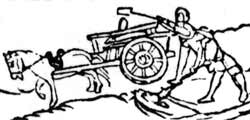 |
Those Who Built the Forts |
 Much
labor was required to wield shovels, picks, wheelbarrows, baskets and
wagons. Not only soldiers but townspeople, peasants, prisoners and
whoever else could have a digging tool thrust into the hands was put
to work. Yes, sometimes women too worked on defenses. To prepare the
Flemish coastal town of Sluys for siege in 1587, two companies of
women were formed, under female captains, who took the names of
"May
in the Heart" and "Catherine the Rose." The fortification they
constructed to secure a threatened point was christened Fort Venus.
Much
labor was required to wield shovels, picks, wheelbarrows, baskets and
wagons. Not only soldiers but townspeople, peasants, prisoners and
whoever else could have a digging tool thrust into the hands was put
to work. Yes, sometimes women too worked on defenses. To prepare the
Flemish coastal town of Sluys for siege in 1587, two companies of
women were formed, under female captains, who took the names of
"May
in the Heart" and "Catherine the Rose." The fortification they
constructed to secure a threatened point was christened Fort Venus.
 In 1642 and early 1643, to hold London for Parliamentarian forces
against the threat of a Royalist army, siegeworks were hurriedly
made, with children even put to work. Poet
Samuel Butler commented: "From ladies down to oyster wenches/Laboured
like pioneers in trenches." Gentlemen and clerks too dirtied
themselves. So pressing was the threat that clergy permitted
digging to go into Sundays, claiming this was the Lord's work.
In 1642 and early 1643, to hold London for Parliamentarian forces
against the threat of a Royalist army, siegeworks were hurriedly
made, with children even put to work. Poet
Samuel Butler commented: "From ladies down to oyster wenches/Laboured
like pioneers in trenches." Gentlemen and clerks too dirtied
themselves. So pressing was the threat that clergy permitted
digging to go into Sundays, claiming this was the Lord's work.
Defenses of Florence, the Papal States and the Knights of Malta were built by criminals and galley slaves. Danish kings made use of their peasants but did not pay them. Although Venetians paid their peasants for work on Crete, the amount was paltry.
Soldiers had a notoriously low regard for this type of work and
bent their backs to it reluctantly. Indeed, for some minor
trenching or maintenance for which not many may have been needed,
working the shovels was a method of punishment. To goad their men,
commanders such as King Gustavus Adolphus, Van Nassau, Parma, Guise
and Montluc on occasion took shovel in hand to demonstrate that, when
a task must be done, it will be done regardless who does it.

At the end of the 16th century, Maurits van Nassau hit upon a method of enthusing soldiers and civilians to build fortifications: pay them well. According to F. Ten Raa, Het Staatsche Leger 1568-1795, pay rate for soldiers could be as much as 20 times their normal in "dangerous and hazardous situations." Unfortunately for both the soldiers and their commanders, when contractors were brought in to be intermediaries in the process, there could be erosion of funds passing through their hands.
Someone at the time of Van Nassau grumbled about the labor: "...the works which are performed by 'commanded' soldiers end up by being incomplete and very costly. They prove so expensive because all the soldiers are set to work, regardless of the fact that many of them have never held a shovel or spade before in their lives. The French are the worst of all, for they spend most of their time on the site in joking and playing. A single Frisian or other hardworking man will do more in a single day than four Frenchmen." (from F. Ten Raa)
The labor force required to throw up an earthen fort did not have to possess any particular skills, only strong backs and calloused hands. That skill level also applied to constructing masonry forts - but masonry required in addition the skills of masons, brickmakers and carpenters, which added to the cost. Furthermore, while an officer or engineer could stroll into a town and recruit unskilled muscle at every corner, experienced masons were not common - and many may have been needed for a particular project. For example, in 1647, to build new features outside the main walls of Milan, engineers estimated that 300 masons would be required - all working at the same time.
| Back |
Bland not Grand |
|
|
|